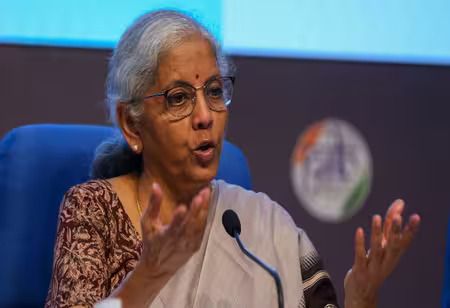
FM Links Pension Reforms to Atmanirbhar Bharat Vision


Asserting that strong pension and retirement solutions must be the cornerstone of India's social security framework, Finance Minister Nirmala Sitharaman stated that the success of Atmanirbhar Bharat, a self-reliant India, depends as much on financially independent households as it does on industry.
Sitharaman emphasized that recent changes to the National Pension System (NPS) are intended to address both the supply and demand sides of retirement planning and pension framework, saying, "The robustness of the social security framework that is provided to them depends on the growth of any nation."
The finance minister stated that the recent reforms were intended to address both the supply and demand sides of India's pension framework, from the industry as well as the consumer perspective, during a conference held in the nation's capital by the Pension Fund Regulatory and Development Authority (PFRDA).
“The fiscal gains of a robust pension system are actually real. Domestic savings deepen, and capital can be used for the long term,” she said.
“But the human gains are deeper....fewer families are pushed into distress by an illness and loss of income in old age, and more seniors living with agency and not dependency,” she added.
Also Read: Engineer’s Day 2025: Celebrating Five Most Renowned Engineers
With changes to NPS that offer more flexibility, openness, and accessibility for millions of members, India's pension system is undergoing a comprehensive transformation. The reforms, which take effect on October 1, 2025, are shaped by provisions in the 2024 Union Budget and subsequent regulations. They enable non-government subscribers to manage numerous schemes under a single account, invest up to 100% of their contributions in stocks, and take advantage of faster settlement cycles.
Along with other reforms, the PFRDA has implemented initiatives to increase participation, including as the introduction of a Unified Pension Scheme for central government employees and NPS Vatsalya for minors. Aadhaar-based verification is now required to bolster security, and retirement planning is intended to be more accessible through streamlined withdrawal and exit regulations.
Also Read: PM Modi Turns 75: Key Records and Milestones of His Journey
While updated prices for government subscribers and revised charges for central record-keeping agencies (CRAs) aim to strike a balance between efficiency and sustainability, pension funds can create bespoke schemes under the new framework that cater to varying risk tolerances. In a nation where the number of senior people is expected to be more than double by the middle of the century, these reforms collectively represent one of the most ambitious attempts to increase retirement security to date, Sitharaman said. Sitharaman said that contemporary retirement goals extend beyond basic sustenance and cited shifts in job patterns.
“The traditional model of a single lifelong job with a defined pension is also becoming rare. Today's workforce is characterized by job mobility and entrepreneurship,” she said.
Also Read: 5 Major CPO Appointments in 2025
“This makes employers' pensions less reliable for an entire career and therefore places the onus on the individuals to build their own portable, long-term retirement plans,” she added.
The finance minister reaffirmed that the establishment of the NPS in 2004 by the NDA government at the time marked a significant shift to a defined contribution pension system that is sustainable.